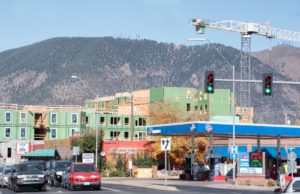 A steady upward trajectory in the Flagstaff economy throughout the remainder of this year and into 2018 promotes continued growth in the construction and retail trades amidst local challenges and a more hostile worldwide environment. So shares Ron Gunderson, Ph.D., emeritus professor of economics in the College of Business at Northern Arizona University.
A steady upward trajectory in the Flagstaff economy throughout the remainder of this year and into 2018 promotes continued growth in the construction and retail trades amidst local challenges and a more hostile worldwide environment. So shares Ron Gunderson, Ph.D., emeritus professor of economics in the College of Business at Northern Arizona University.
Insights from Gunderson and Lee McPheters, Ph.D., research professor of economics in the W.P. Carey School of Business at Arizona State University (ASU), paint an evolving canvas of economic indicators at the local, state and national levels.
“NAU and tourism, the two major drivers of the Flagstaff economy, are both likely to continue to move ahead on steadily upward and persistent paths,” Gunderson explained. “I expect local construction will remain on the path which has led to growth in the number of apartment complexes in town, along with additional hotels and restaurants across the city. Much of this will be a continuation of activities already underway.”
The impetus, Gunderson stated, has been response to demand for housing from continued growth in enrollment at NAU, along with travel and tourism spurring demand for local food and lodging enterprises.
“This growth brings additional dollars to Flagstaff through the increase in the number of jobs in the construction and retail sectors,” he noted, “but it also carries a host of challenges which are well known to most local residents — more traffic and parking issues, ongoing concerns about the use of open spaces and heightened emotions regarding alternative uses of land when redevelopment occurs.”
The broader Arizona economy portends no “gloom,” “doom” or “boom,” according to the Economic Outlook 2017-18 championed by ASU’s McPheters. That forecast instead calls for basking in a little oomph from population influx, job creation, defense spending, health care hiring, international trade and infrastructure rejuvenation. The biggest risks remain the national economy and global influences clouding those little rays of sunshine both locally and statewide.
With 6.8 million residents in 2016, Arizona holds title as the 14th largest state and boasts the eighth fastest population growth, McPheters said. New residents totaled 113,000, taking fifth place for that economic indicator. In international migration, the state ranks 17. Only Florida, Texas, and Washington outpace Arizona in domestic migration.
McPheters anticipates “mixed” growth in Arizona jobs, employment, unemployment, retail sales and single family permits during the Trump presidency. The state slipped from the top 10 nationally in overall job growth, but ranks 11th in private job creation year to date. Across sectors, Arizona scores number one in job growth for both finance activities and food service, and rates 8th in manufacturing, 11th in health care and 26th in construction.
“Growth rates in the [Flagstaff] area in 2018 will not diverge much from what we are experiencing in 2017,” Gunderson predicted. “Barring any unforeseen disasters, the current momentum appears to be sufficient to provide a moderate, but steady increase in local economic activities. My expectations are based on the assumption that the national and global economies do not implode. However, the worldwide environment is more hostile today than has been the case for many decades and unforeseen events could certainly lead to a major divergence from these predictions.”
Statewide, the increase in minimum wage did not slow Arizona food service hiring in first quarter 2017, McPheters said, citing a record 15,240 new jobs in the sector.
Gunderson noted that locally reliable data does not exist to “provide a definitive answer that measures the extent of the impact of the 2017 minimum wage increase” on Flagstaff. However, he reported that some retail establishments have closed and that he has spoken with employees whose hours have been reduced.
“Without a formal study, it is difficult to arrive at any hard numbers,” Gunderson concluded, while explaining that businesses typically migrate to locations where they can optimize return on investment. Businesses requiring large numbers of minimum-wage workers, for example, may establish operations in nearby unincorporated areas outside the limits of minimum wage municipalities. The negative impacts of such relocation, he pointed out, can be urban sprawl, increased commute times and forfeiture of potential city tax revenue.
“The better approach to raise income levels is to initiate tax and income policies, including tax rebates and income tax credits, to people whose incomes fall below a particular level,” Gunderson said. “Under these types of strategies, the location of future business investment is not distorted by mandated wage costs when those costs exceed the productivity of workers performing those tasks.”
The ongoing attainment of Arizona growth requires that domestic migration retain its strong pace, and the Arizona labor force, quality of life and cost structure remain solid, according to McPheters. Potential disruptors, he noted, could include new policies on trade/NAFTA and the state failing to “deal with major problems, such as infrastructure and education, for long term growth.”
McPheters portrayed “low real income” as the “main headwind” in consumer spending as “the recession hangover continues.” Paradoxically, both consumer confidence and consumer worry are up following the presidential election. While investors remain optimistic about Trump reforms, McPheters said, skeptics assert that “somebody still has to pay for government.”
Arizona scores below the national average in economic prosperity. Per data from 2015, the state ranks 42nd in per capita personal income and 43rd in per capita GDP. About one-third of the state’s residents receive government aid, including 25 percent on Medicaid, McPheters said.
Presidential appointment of a Federal Reserve chairperson in early 2018 and other open positions on the Board of Governors could alter the future direction of federal monetary policy and affect markets, Gunderson shared.
“The future direction of Fed policy could emerge as a reflection of many new faces on the Board, not just those of the Chair,” he explained. “Nevertheless, substantial differences exist among the various individuals under consideration for the Fed Chair. [Janet] Yellen’s support of an easy money policy, combined with a gradual lifting of interest rates, could be replaced with a policy to tighten monetary policy by raising interest rates sooner rather than later, or even by a formula-driven rule to dictate interest rate changes over time.”
The vulnerability, Gunderson clarified, is that “any change which raises interest rates too rapidly could cut the flow of investment and quickly lead to reductions in the stock market and the housing market, as well as disrupt the plans of many local businesses who may have been considering borrowing funds to expand their facilities and operations.”
Brighter skies surround defense, health care, international trade and infrastructure. Defense spending totals $10 billion in Arizona and contributes 3.4 percent of the state’s GDP.
Health care has become the largest employer in a majority of states and accounts for 20 percent of new jobs in Arizona, McPheters said.
Infrastructure spending could boost Arizona’s economic growth, McPheters explained, providing greater economic stimulus than tax cuts. He described how every job in the aggregates industry (manufacturers and suppliers of construction and building materials) generates nearly five additional jobs in other industries and every dollar sold in aggregates produces another $3.47 of sales in other industries.
International trade supported more than 100,000 jobs in Arizona during 2016, with exports totaling $22 billion. Migration to Arizona from international locations is down by half since 2001, to 14,861. Domestic migration simultaneously has risen to 61,544. Unauthorized immigrants in Arizona numbered 244,000 in 2014, and the state is home to 28,000 recipients of Deferred Action for Childhood Arrivals (DACA).
“Low volatility belies uncertainty, [despite] no recession on the horizon,” McPheters said. He offered “two cheers” for second quarter 2017 U.S. GDP at an adjusted 3.2 percent. Risks to potential economic growth nationwide include trade wars and protectionism limiting output; loss of exports due to a strong dollar; reforms stymied by Washington gridlock; weak increases in productivity; overly tightened Federal Reserve policy; and North Korea.
U.S. GDP is expected to show slightly higher rates in 2018 at 2.4 percent, job creation at 2.4 million, and housing starts at 1.3 million. Estimates point to GDP below 3 percent through 2020 and beyond, prompting McPheters to consider “a new norm.”
Obstacles to the Trump administration’s goal of 3 percent growth in annual GDP include lower productivity from retiring Baby Boomers leaving the workforce, weaker investment and less innovation. A big question, McPheters poses, is “how to build homes for the under $225,000 market and still make a profit.”
Gunderson cites the ongoing shortage of housing for purchase or rent at lower price points as “one of the more persistent challenges facing the Flagstaff region. The general lack of available land to build upon, along with higher costs of construction compared with many other locations in the state, continues to depress the potential for increased supply of new low-priced homes, while the ongoing increases in the local and student populations expand the pressure from the demand perspective.”
Traffic congestion, another challenge, requires “a combination of alternative approaches, including increased public transit and other means to reduce the dependence on automobiles.” Longer-term solutions involve street widening and new roadways.
“We live in a time of considerable uncertainty with respect to future directions in the economy and a number of situations may occur that could unsettle the economy, and nullify any predictions for the coming year,” Gunderson concluded.
He repeats advice he has given in previous years about business operations during any economic cycle: “If businesses have developed a solid proposal which outlines their plan of action for the coming year, they should use it and only make modifications when they have new information that alters the outcome.” FBN
By Sue Marceau, FBN







